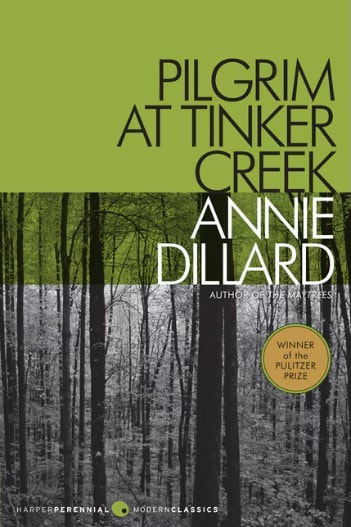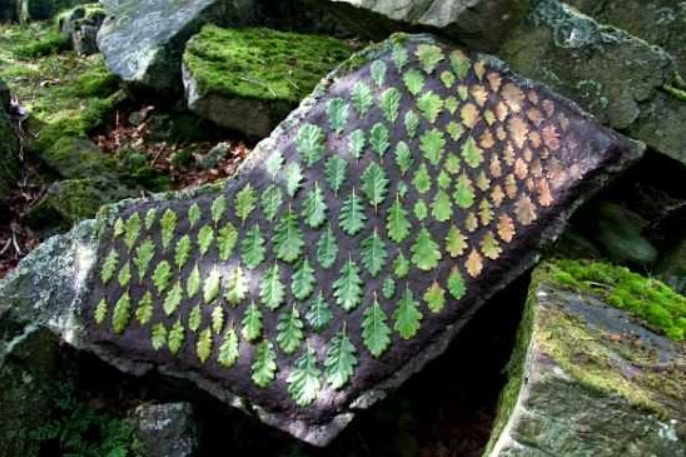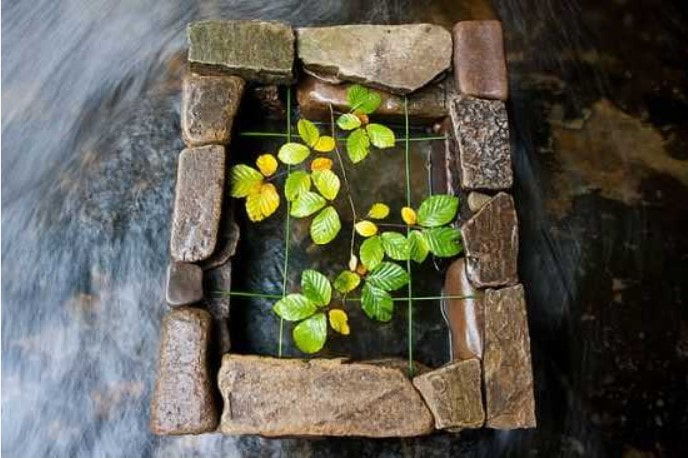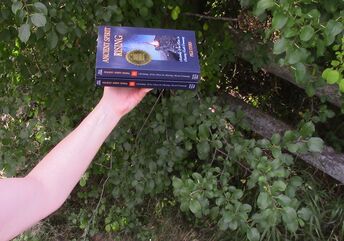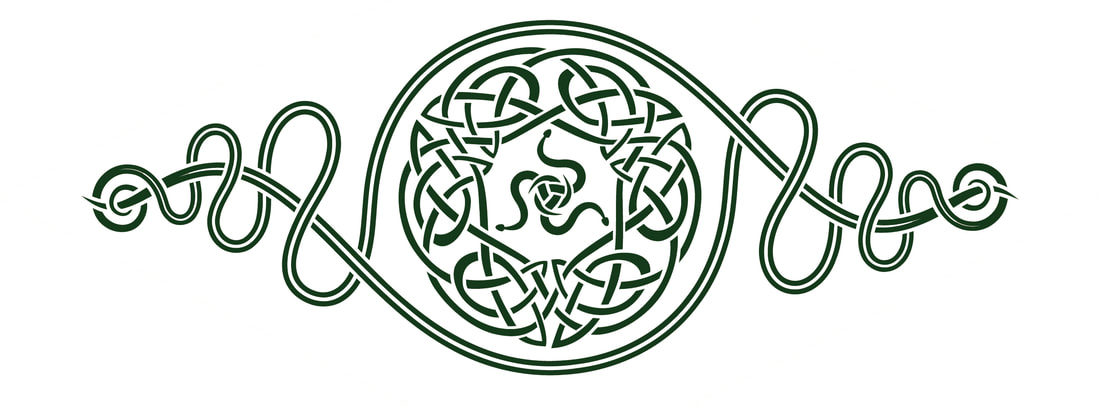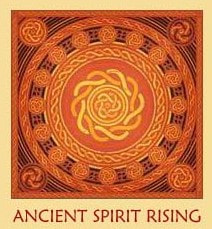REVIEW BY PEGI EYERS
Happy 50th Anniversary to Pulitzer Prize-winner PILGRIM AT TINKER CREEK by Annie Dillard~! Originally published by Harper & Row, PILGRIM is a year-long collection of essays by Dillard as she chronicles a dramatic year in Virginia’s Roanoke Valley. Harper Perennial, March 2024
My first reading of Pilgrim at Tinker Creek took place twenty years ago, and at that time I had the impression that Annie Dillard was a mystic-type poetic goddess, able to conjure up sweeps of esoteric imagery from her intense studies and rambles in nature. Now, with my second reading many years later, I can say that her approach to the natural world is not as mysterious as I first thought - she has a firm grounding in natural science, biology, and literature as related to the study of the land. The scientific theories she quotes may seem dated, but her descriptions of the perennial life and abundant growth in natural creation have not lost their lustre. In fact, her reverence and intensity for wild places is even more important now, in these times of environmental threat. For me, the passionate voice of Annie Dillard speaks on behalf of all the fragility, wonder and beauty that is in nature.
Winner of the Pulitzer Prize and a classic of modern environmental literature, Dillard's discourse in Pilgrim at Tinker Creek weaves in-depth information and personal impressions on climate, terrain, biology, plants, trees, insect/animal/bird structure and behavior, birth, death and the seasons, and running through all these observations and insightful comments is the steady constant of Tinker Creek. At home on the banks of the creek for many years, Annie Dillard has become deeply connected to place, and we can see the effects of the environment on her worldview, consciousness, health and spiritual beliefs. She discusses the alternate reality of life in the city, and how urbanization is now taken for granted.
"I remember what the city has to offer: human companionship, major league baseball, and a clatter of quickening stimulus like a rush from strong drugs that leaves you drained. I remember how you bide your time in the city, and think, if you stop to think, “next year…..I’ll start living; next year……I’ll start my life.”
Winner of the Pulitzer Prize and a classic of modern environmental literature, Dillard's discourse in Pilgrim at Tinker Creek weaves in-depth information and personal impressions on climate, terrain, biology, plants, trees, insect/animal/bird structure and behavior, birth, death and the seasons, and running through all these observations and insightful comments is the steady constant of Tinker Creek. At home on the banks of the creek for many years, Annie Dillard has become deeply connected to place, and we can see the effects of the environment on her worldview, consciousness, health and spiritual beliefs. She discusses the alternate reality of life in the city, and how urbanization is now taken for granted.
"I remember what the city has to offer: human companionship, major league baseball, and a clatter of quickening stimulus like a rush from strong drugs that leaves you drained. I remember how you bide your time in the city, and think, if you stop to think, “next year…..I’ll start living; next year……I’ll start my life.”
Reading Annie Dillard is like scrolling through a series of dreams in which everything is alive with possibility, and pregnant with primal power. She includes the cognitive in all of her grounded flights of fancy, with examinations in psychology, human response and behavior, the nature of thought, and preferential states of mind such as innocence.
"Innocence sees that this is it, and finds it world enough, and time. Innocence is not the prerogative of infants and puppies, and far less of mountains and fixed stars, which have no prerogatives at all. It is not lost to us; the world is a better place than that. Like any other of the spirit's good gifts, it is there when you want it, free for the asking, as has been stressed by stronger words than mine.”
The opposite of innocence is self-consciousness, which hinders the immediate experience of being wholely here, in the present moment. When one can lose oneself in wonder - in a present, timeless no-self contemplation of nature - a luminous gift occurs with the sensory recognition of the divine, which is the alive in creation and ourselves. Dillard's insight into the spiritual dimensions of deep connection to place is marvelous and inspiring, and affirms one of my favorite quotations from a passage by Lew Welch.
"The forest is the original cathedral. Light filtering through the green leaf windows floods the arched nave of the trees with wonder.”
"Innocence sees that this is it, and finds it world enough, and time. Innocence is not the prerogative of infants and puppies, and far less of mountains and fixed stars, which have no prerogatives at all. It is not lost to us; the world is a better place than that. Like any other of the spirit's good gifts, it is there when you want it, free for the asking, as has been stressed by stronger words than mine.”
The opposite of innocence is self-consciousness, which hinders the immediate experience of being wholely here, in the present moment. When one can lose oneself in wonder - in a present, timeless no-self contemplation of nature - a luminous gift occurs with the sensory recognition of the divine, which is the alive in creation and ourselves. Dillard's insight into the spiritual dimensions of deep connection to place is marvelous and inspiring, and affirms one of my favorite quotations from a passage by Lew Welch.
"The forest is the original cathedral. Light filtering through the green leaf windows floods the arched nave of the trees with wonder.”
Dillard's odyssey through place, time and space, as inspired by the environs of Tinker Creek, provides a glimpse into the possible meanings inherent in creation, and the awesome, often violent powers in the natural world. As an artist and poet, I found that a prose-poem format for Dillard’s river-wide flow of concepts to be incredibly effective. A Pilgrim at Tinker Creek engages with:
seeing the obvious and then stalking the hidden in nature - the invisible worlds behind the light – offers the realization that our minute perceptions of our textured environment are only a speck in the infinite reach of universes;
how language erects boundaries around the visible;
the paradoxical mysteries in migration, hibernation and evolution, and that life does not cease to thrive, even in winter;
speculations about the nature of early explorations in arctic lands, the idiosyncracies of muskrats, fish, frogs, spiders, salamanders, beetles, monarch butterflies, plankton, locusts, fleas, snapping turtles, luna moths and praying mantises;
the unbelievable adaptation of creatures to the natural environment;
the interesting possibility that the moon emits a warmth that can actually be felt by the sensitive;
the mysteries in knotted snakeskins that mirror the continuous loop in time and creation;
the transcendental nature of illuminated moments in quiet contemplation;
the amazing resiliency and characteristics of trees;
the cycles of seasons and biological lifeforms, the healing power of rushing waters;
the impossibility of capturing the moment that vibrant, blossoming spring actually happens;
seeing the obvious and then stalking the hidden in nature - the invisible worlds behind the light – offers the realization that our minute perceptions of our textured environment are only a speck in the infinite reach of universes;
how language erects boundaries around the visible;
the paradoxical mysteries in migration, hibernation and evolution, and that life does not cease to thrive, even in winter;
speculations about the nature of early explorations in arctic lands, the idiosyncracies of muskrats, fish, frogs, spiders, salamanders, beetles, monarch butterflies, plankton, locusts, fleas, snapping turtles, luna moths and praying mantises;
the unbelievable adaptation of creatures to the natural environment;
the interesting possibility that the moon emits a warmth that can actually be felt by the sensitive;
the mysteries in knotted snakeskins that mirror the continuous loop in time and creation;
the transcendental nature of illuminated moments in quiet contemplation;
the amazing resiliency and characteristics of trees;
the cycles of seasons and biological lifeforms, the healing power of rushing waters;
the impossibility of capturing the moment that vibrant, blossoming spring actually happens;
the "spiritual" energy of wind;
the intricate mysteries of green cell growth and photosynthesis;
that this intricacy suggests an unfathomable intelligence at work;
the transitory nature of summer floods;
the nature of human mortality;
the unsentimentality of life for both predator and prey in the food chain;
the intimacy and familiarity with her terrain that leads to the active stalking of phenomena and creatures [this is the part that impressed me most];
that Newtonian physics falls woefully short of measuring and describing the unknown;
sleeping in the open as a connective experience to the natural world;
the "if a tree falls in the forest, will anybody hear?” analogy to realize that nature is busily procreating and thriving, out of the range of human consciousness;
her strange dream of a shamanic prayer tunnel;
and finally, knowing that a life spent in the presence of nature is full of both "tranquility and trembling."
the intricate mysteries of green cell growth and photosynthesis;
that this intricacy suggests an unfathomable intelligence at work;
the transitory nature of summer floods;
the nature of human mortality;
the unsentimentality of life for both predator and prey in the food chain;
the intimacy and familiarity with her terrain that leads to the active stalking of phenomena and creatures [this is the part that impressed me most];
that Newtonian physics falls woefully short of measuring and describing the unknown;
sleeping in the open as a connective experience to the natural world;
the "if a tree falls in the forest, will anybody hear?” analogy to realize that nature is busily procreating and thriving, out of the range of human consciousness;
her strange dream of a shamanic prayer tunnel;
and finally, knowing that a life spent in the presence of nature is full of both "tranquility and trembling."
Annie Dillard tells us, "I am not a scientist. I explore the neighbourhood.”
And yet Dillard’s scientific research, spiritual allegories and lively accounts are evocative of the biologist as both mystic and poet. Pilgrim at Tinker Creek is an unforgettable foray into the life-giving elements of wind, water, earth and fire, the mysteries of creation, the undaunted human spirit, the unquenchable urge for growth, and the vastness of time and infinity. Her citations from science and literature are highly appropriate and thought-provoking, such as this masterpiece from Dylan Thomas.
“The force that through the green fuse drives the flower/Drives my green age."
And this treasure, in her own words:
"Our life is a faint tracing on the surface of mystery. The surface of mystery is not smooth, any more than the planet is smooth. These are our live seasons. Let us live them as purely as we can, in the present."
And yet Dillard’s scientific research, spiritual allegories and lively accounts are evocative of the biologist as both mystic and poet. Pilgrim at Tinker Creek is an unforgettable foray into the life-giving elements of wind, water, earth and fire, the mysteries of creation, the undaunted human spirit, the unquenchable urge for growth, and the vastness of time and infinity. Her citations from science and literature are highly appropriate and thought-provoking, such as this masterpiece from Dylan Thomas.
“The force that through the green fuse drives the flower/Drives my green age."
And this treasure, in her own words:
"Our life is a faint tracing on the surface of mystery. The surface of mystery is not smooth, any more than the planet is smooth. These are our live seasons. Let us live them as purely as we can, in the present."
LAND ART BY RICHARD SCHILLING
Adapted from a report by Pegi Eyers for Sehdev Kumar, University of Waterloo course, "Nature, Art, Myth and Folklore" Fall 1995
Pegi Eyers is the author of "Ancient Spirit Rising:
Reclaiming Your Roots & Restoring Earth Community"
an award-winning book that explores strategies for intercultural
competency, healing our relationships with Turtle Island First Nations, uncolonization, recovering an ecocentric worldview, rewilding, creating a sustainable future and reclaiming peaceful co-existence in Earth Community.
Available from Stone Circle Press or Amazon.
Reclaiming Your Roots & Restoring Earth Community"
an award-winning book that explores strategies for intercultural
competency, healing our relationships with Turtle Island First Nations, uncolonization, recovering an ecocentric worldview, rewilding, creating a sustainable future and reclaiming peaceful co-existence in Earth Community.
Available from Stone Circle Press or Amazon.
